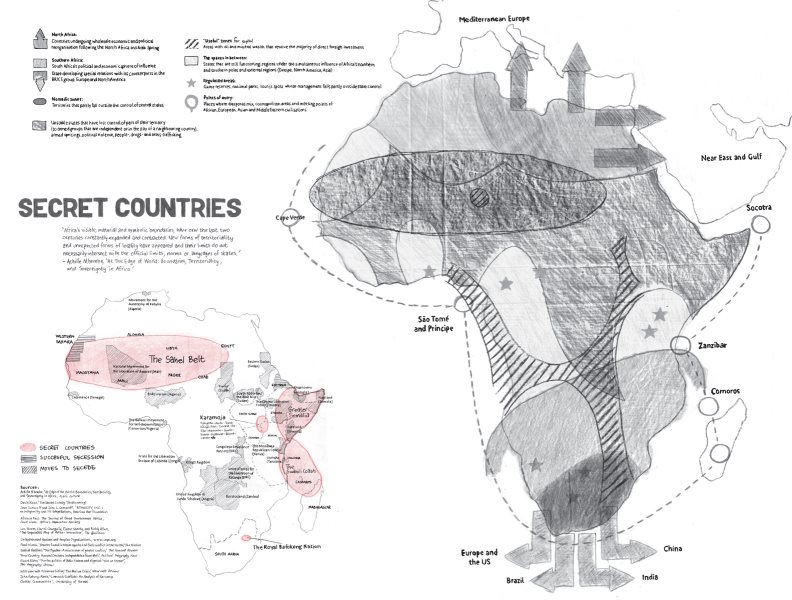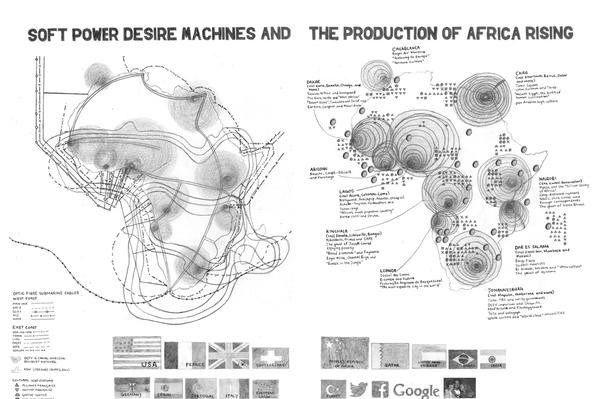The Chimurenga Chronic is a pan-African publication borne out of an urgent need to write our world differently, to begin asking new questions, or even the old ones anew. As part of the bigger Chimurenga project, they question academic and conceptual conceptsborn out of Western scholarship which reinforce, or even create, dichotomies based on otherness and segregation, such as North/South, Centre/Periphery, etc. In the field of cartography, as Alberto Toscano and Jeff Kinkle point out in the opening chapter to Cartographies of the Absolute (Zero Books, 2015), imperial capitalism has been the main driver behind efforts to map scientifically and in great details the “terra nullius” of potential colonies. And the constant strive towards locating resources more accurately and more totally also remains an import from the West, according to the editors at Chimurenga:
“Our reality cannot be mapped only by GDP, GDS, IDF and related indicators of “development”. Scales, set squares and compasses alone would not work; we also require hands, feet and hearts. And memory. Memory is central – here is Wendell Hassan Marsh: “Because memory is so often developed from non-written texts, these narratives are more difficult to trace because of the scarcity of traces, but deep in the ideologies, practices, and politics of those denied history is an ethereal yet very real memory that is un-stated but nonetheless dis-static. In other words, History is the science of the state, while memory is the art of the stateless.”
Check out their March 2015 issue entitled New Cartographies: it opens with the question, “what if maps were made by Africans for their own use, to understand and make visible their own realities or imaginaries?”
Below is a general statement from the Chimurenga Chronic website:
When will the new emerge – and if it is already here, how do we decipher it? In which ways do people live their lives with joy and creativity and beauty, sometimes amid suffering and violence, and sometimes perpendicular to it? How do people fashion routines and make sense of the world in the face of the temporariness or volatility that defines so many of the arrangements of social existence here?
These questions loom over a contemporary Africa. Yet most knowledge produced on the continent remains heavily reliant on simplistic and rigid categories unable to capture the complexities that inflect so much of contemporary quotidian life here.
The Chronic is one small, deeply subjective attempt to do things differently. Ironically, we started with what we know, taking inspiration from the flexibility, readiness to take risks, and ability to manoeuvre through different temporal orders that defines life here.
We recognised the newspaper – a popular medium that raises the perennial question of news and newness, of how we define both the now and history, as the means to best engage the present; this question of thinking and writing critically about contingency and human agency today. We selected the medium both for its disposability and its longevity, its ability to fashion routine in a way that allows us to traverse, challenge and negotiate liminality in everyday life.
We wrote, we got our friends and partners to write, draw and photograph, we edited, and we compiled. We sought out stories that articulate the complexity, the innovation, thinking and dreams – all the things that make life sustainable in this place. We favoured writing, art and photography that is open, plural, and inflected by the workings of power, innovation, creativity and resistance – yes, resistance.


